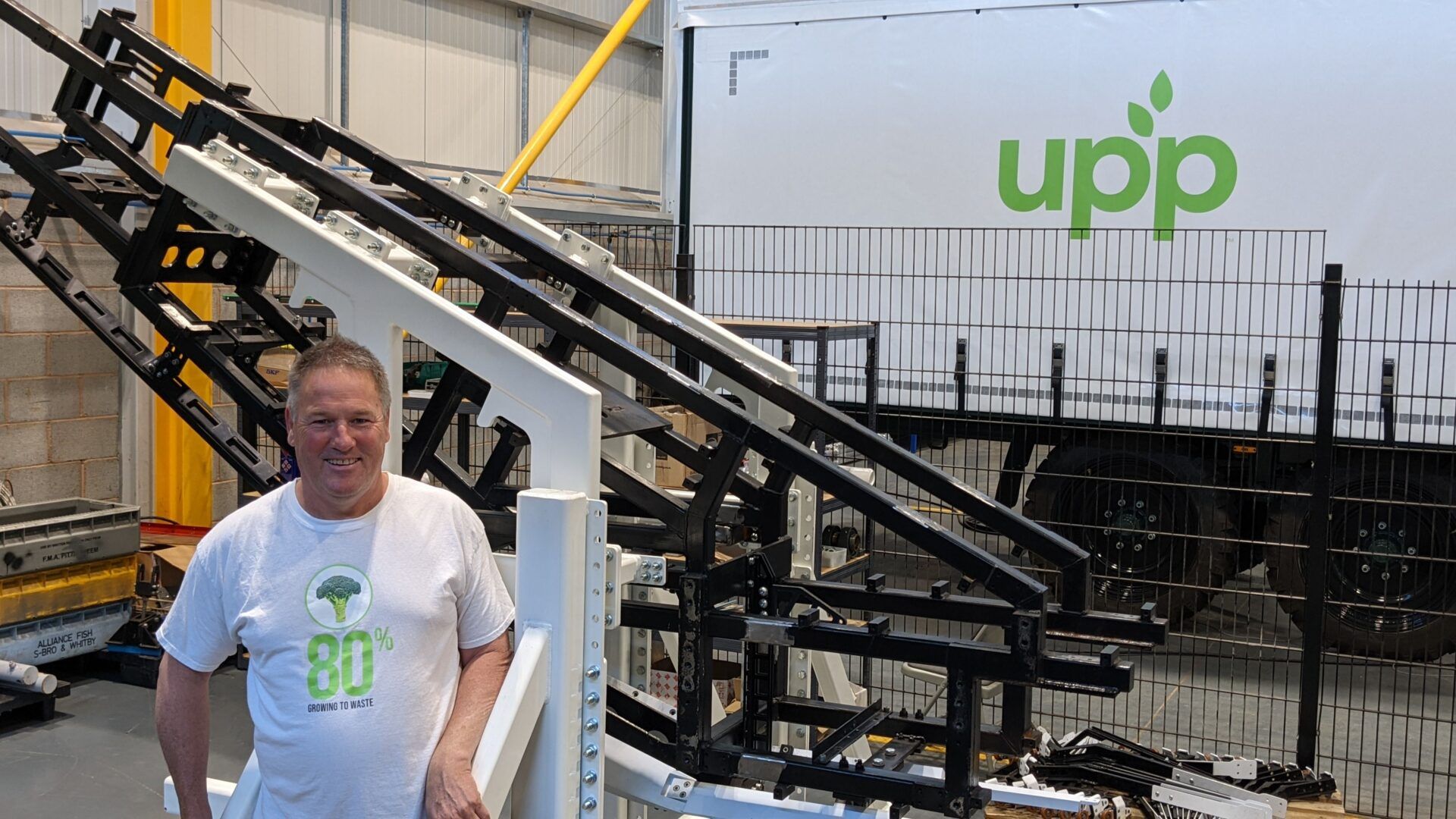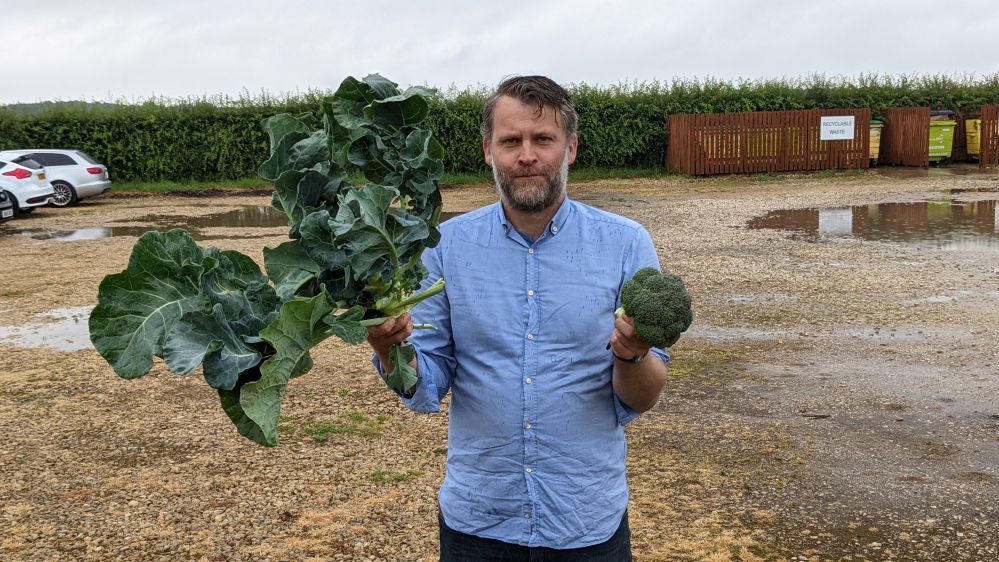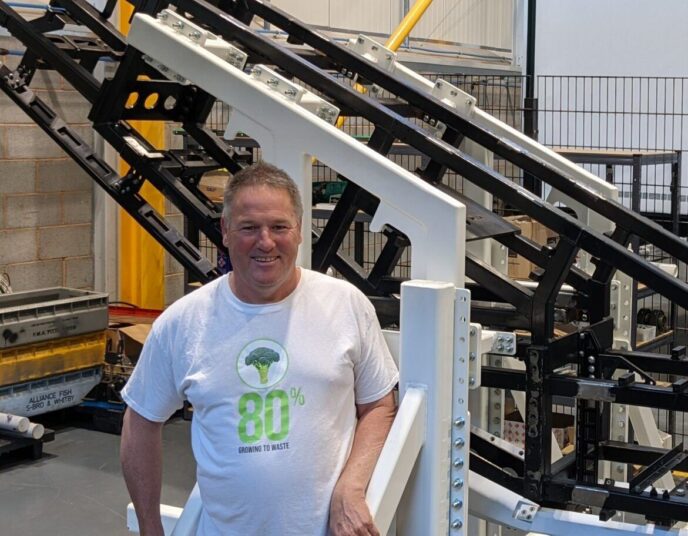Figures from the UK’s Department of Environment, Food & Rural Affairs (DEFRA) suggest that 80% of broccoli biomass (600,000+ tons in the UK alone) is wasted annually, from unwanted stems, stalks and leaves, to broccoli heads/crowns that don’t meet supermarket specs.
Which, from a nutritional, economic, and sustainability perspective, is crazy, observes UPP (Upcycled Plant Power) founder and CEO David Whitewood, who is developing two distinct technology platforms to tackle the problem.
The first is a patented harvester deploying computer vision and machine learning to harvest broccoli with minimal waste. The second is on-farm upcycling units enabling UPP to extract proteins, fibers and sugars from broccoli stems, stalks, and leaves, thereby utilizing more of the crop for human food applications.
Armed with £500,000 ($637,473) pre-seed funding from Elbow Beach Capital and an £800,000 ($1.02 million) grant from DEFRA and UK Research and Innovation (UKRI), UPP is working with agrifoodtech researchers and engineers at the James Hutton Institute and the Agri-EPI Centre as part of the SusProt (sustainable protein) consortium. Food companies including Coca-Cola-backed Innocent Drinks are in turn testing the upcycled broccoli ingredients in everything from smoothies to plant-based sausages.
AgFunderNews (AFN) caught up with Whitewood (DW) to find out more about UPP, which was established last year as a spinout from agtech business Earth Rover.

AFN: How is broccoli typically harvested?
DW: By hand. Farm laborers walk through the fields with knives and cut each broccoli head individually.
AFN: Why isn’t harvesting mechanized?
DW: One reason is that broccoli heads don’t all ripen at the same time, so you have to pass through the crop multiple times to maximize your yield. The other is that robotic harvesting attempts have tended to be too slow or they damage the head, and if you do that, nobody wants it; the value is destroyed instantly.
AFN: How has UPP tackled these issues?
DW: So we’re using machine learning and computer vision to look at the heads and assess whether they are ripe, even if they are partly obscured by leaves, so we’re looking for heads of a certain diameter. Even within the same row, there can be variation. And then we have a patented mechanism, which is the way we protect the crop while we’re passing our grabbing fingers through it, if you like.
We basically come down through the crop with mechanical fingers and squeeze the leaves up around the plant to protect the head. And then a circular saw comes out, cuts the plant away and lifts it from the field.
While you still have to go back a few times [to get the broccoli heads that ripen later], we can move very fast, at a rate of up to 3km/hour, plus we’re also mapping the crop, so we know where the heads we still need to pick are. The other benefit is that we can do this at night, whereas you don’t want people going out into fields in the dark with sharp knives!
AFN: What interest have you had from farmers in the harvesting technology?
DW: We have had significant interest from growers in California, Spain, and the UK who are ready to use this machine, which we’re showing to them in September. We expect to be signing contracts for harvesting in 2024 in the UK and Spain and then shortly after in California.

AFN: So tell us about the upcycling part of your operation…
DW: We take the stems, stalks and leaves and we turn them into a protein fraction, a fiber fraction, and a sugary fraction on farm without any fancy equipment. So part of the deal with farmers using our harvester is that we get access to the side stream [the leaves, stalks, and stems], and then we will be putting our upcycling units on farm.
It’s a pretty simple process. We squash the biomass and we get a protein-rich juice and a pressed fibrous cake, which is about 45% fiber with some proteins and sugars left in it. We then ferment that with cultures to preserve it, so that can be used potentially in alt meats and baked goods. We then separate the protein-rich juice into a clear and a green fraction.
The green liquid is clarified, but the protein is not denatured, and we’ve worked with partners to incorporate that into everything from smoothies to plant-based meats.
The clear juice is rich in sugars and we’re looking at applications for that to see if it could be used as a feedstock for fermentation, or for things like ketchup, which is high in sugar.
AFN: What is attractive about broccoli protein?
DW: Like most plant proteins it’s not a complete protein but can be combined with other plant proteins if you want to increase the PDCAAS [protein digestibility] score. As for functionality, we’re working with the James Hutton Institute to look at properties such as binding and foaming to see if it could function as an egg replacement, for example.
AFN: What food and beverage industry partners are you working with?
DW: We’re working with Samworth Brothers, which is a billion-pound company making pasties, sandwiches and ready meals; Innocent Drinks (owned by Coca-Cola), which makes juices and smoothies; and a confectioner called Lees of Scotland, which specializes in meringues and mallows, which is where the foaming interest comes in. We’ve also had interest from other companies.
AFN: Is there a limited time window between harvesting and processing?
DW: Our initial tests suggest that once you’ve harvested the broccoli, you’ve got a good window of time before the plants start to break down, depending on the temperature. If you put them in a chiller, you can have weeks of time before you have to process them, but obviously the idea is to process them quickly.
And because you can process them onsite at the farm, you don’t have to haul them miles and miles away. It’s not like pea protein, where you might be growing peas in Canada, shipping them to China for processing and then shipping the protein somewhere else again.

AFN: What IP do you have?
DW: Our harvester has a patent issued and we aim to get as many harvesters out there with contracts for farmers’ side streams as possible. The side streams have a second level of protection if you like, because the only [cost-effective] way of really generating them is to use our harvester [which collects broccoli leaves and stalks as well as heads].
AFN: Who’s in the team right now?
DW: Right now it’s me, innovation product lead Joe Sanderson, who has 20+ years of experience in new product development, and my cofounder and principal engineer Martin [Stace], who has a team of five engineers under him. We have a part time CFO, and then on our advisory board, we have Professor Derek Stewart [director of the advanced plant growth centre at the James Hutton Institute].
AFN: How have you funded the business to date?
DW: The initial work on the harvester IP was grant-funded at [agtech company] Earth Rover, then we spun out UPP and brought in £500,000 ($637,473) of pre-seed equity from UK impact investor Elbow Beach Capital. We’ve now got this DEFRA/UKRI grant and we’re raising another £3 million ($3.8 million) in seed funding that should take us to the next stage. But we expect to be generating revenue in 2024, and at breakeven in 2025.
AFN: If you can raise it, what will you spend the seed money on?
DW: We need engineers to get the harvesters ready for different markets. And we need more people like [innovation product lead] Joe [Sanderson] to develop the food side of the business. We also need people to focus on business development.
AFN: What’s your business model?
DW: We intend to rent our harvesters to farmers on a multi-year contract. For the ingredient upcycling, the plan is to have a modular system that we can move from farm to farm, if need be. But more than likely we will leave it on farms for many seasons and we’ll operate it.
AFN: Does your business model rely on you selling the upcycled ingredients or can you make money just from renting out the harvesters?
DW: We can make a margin providing the harvesting services at a cost equivalent to hiring laborers to harvest the crops. But the most interesting part for us is the ingredients side of the business.




